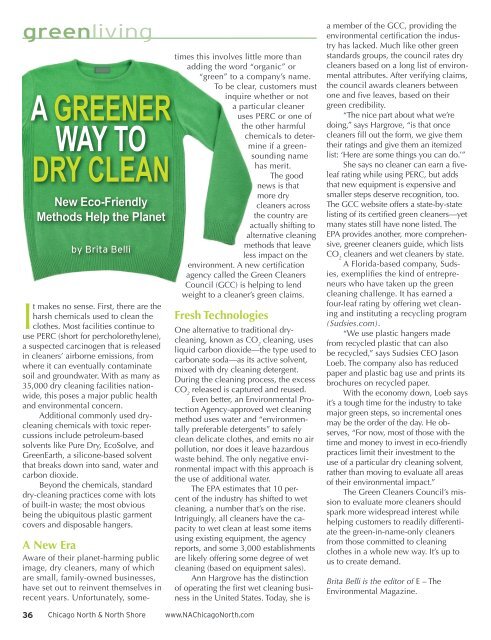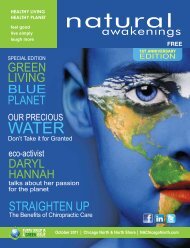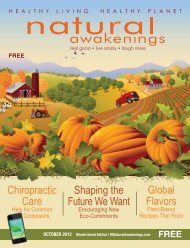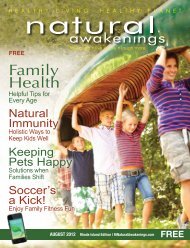Health & Well-Being 5 - Natural Awakenings
Health & Well-Being 5 - Natural Awakenings
Health & Well-Being 5 - Natural Awakenings
You also want an ePaper? Increase the reach of your titles
YUMPU automatically turns print PDFs into web optimized ePapers that Google loves.
greenliving<br />
A GREENER<br />
WAY TO<br />
DRY CLEAN<br />
New Eco-Friendly<br />
Methods Help the Planet<br />
by Brita Belli<br />
It makes no sense. First, there are the<br />
harsh chemicals used to clean the<br />
clothes. Most facilities continue to<br />
use PERC (short for percholorethylene),<br />
a suspected carcinogen that is released<br />
in cleaners’ airborne emissions, from<br />
where it can eventually contaminate<br />
soil and groundwater. With as many as<br />
35,000 dry cleaning facilities nationwide,<br />
this poses a major public health<br />
and environmental concern.<br />
Additional commonly used drycleaning<br />
chemicals with toxic repercussions<br />
include petroleum-based<br />
solvents like Pure Dry, EcoSolve, and<br />
GreenEarth, a silicone-based solvent<br />
that breaks down into sand, water and<br />
carbon dioxide.<br />
Beyond the chemicals, standard<br />
dry-cleaning practices come with lots<br />
of built-in waste; the most obvious<br />
being the ubiquitous plastic garment<br />
covers and disposable hangers.<br />
A New Era<br />
Aware of their planet-harming public<br />
image, dry cleaners, many of which<br />
are small, family-owned businesses,<br />
have set out to reinvent themselves in<br />
recent years. Unfortunately, some-<br />
times this involves little more than<br />
adding the word “organic” or<br />
“green” to a company’s name.<br />
To be clear, customers must<br />
inquire whether or not<br />
a particular cleaner<br />
uses PERC or one of<br />
the other harmful<br />
chemicals to determine<br />
if a greensounding<br />
name<br />
has merit.<br />
The good<br />
news is that<br />
more dry<br />
cleaners across<br />
the country are<br />
actually shifting to<br />
alternative cleaning<br />
methods that leave<br />
less impact on the<br />
environment. A new certification<br />
agency called the Green Cleaners<br />
Council (GCC) is helping to lend<br />
weight to a cleaner’s green claims.<br />
Fresh Technologies<br />
One alternative to traditional drycleaning,<br />
known as CO 2 cleaning, uses<br />
liquid carbon dioxide—the type used to<br />
carbonate soda—as its active solvent,<br />
mixed with dry cleaning detergent.<br />
During the cleaning process, the excess<br />
CO 2 released is captured and reused.<br />
Even better, an Environmental Protection<br />
Agency-approved wet cleaning<br />
method uses water and “environmentally<br />
preferable detergents” to safely<br />
clean delicate clothes, and emits no air<br />
pollution, nor does it leave hazardous<br />
waste behind. The only negative environmental<br />
impact with this approach is<br />
the use of additional water.<br />
The EPA estimates that 10 percent<br />
of the industry has shifted to wet<br />
cleaning, a number that’s on the rise.<br />
Intriguingly, all cleaners have the capacity<br />
to wet clean at least some items<br />
using existing equipment, the agency<br />
reports, and some 3,000 establishments<br />
are likely offering some degree of wet<br />
cleaning (based on equipment sales).<br />
Ann Hargrove has the distinction<br />
of operating the first wet cleaning business<br />
in the United States. Today, she is<br />
36 Chicago North & North Shore www.NAChicagoNorth.com<br />
a member of the GCC, providing the<br />
environmental certification the industry<br />
has lacked. Much like other green<br />
standards groups, the council rates dry<br />
cleaners based on a long list of environmental<br />
attributes. After verifying claims,<br />
the council awards cleaners between<br />
one and five leaves, based on their<br />
green credibility.<br />
“The nice part about what we’re<br />
doing,” says Hargrove, “is that once<br />
cleaners fill out the form, we give them<br />
their ratings and give them an itemized<br />
list: ‘Here are some things you can do.’”<br />
She says no cleaner can earn a fiveleaf<br />
rating while using PERC, but adds<br />
that new equipment is expensive and<br />
smaller steps deserve recognition, too.<br />
The GCC website offers a state-by-state<br />
listing of its certified green cleaners—yet<br />
many states still have none listed. The<br />
EPA provides another, more comprehensive,<br />
greener cleaners guide, which lists<br />
CO 2 cleaners and wet cleaners by state.<br />
A Florida-based company, Sudsies,<br />
exemplifies the kind of entrepreneurs<br />
who have taken up the green<br />
cleaning challenge. It has earned a<br />
four-leaf rating by offering wet cleaning<br />
and instituting a recycling program<br />
(Sudsies.com).<br />
“We use plastic hangers made<br />
from recycled plastic that can also<br />
be recycled,” says Sudsies CEO Jason<br />
Loeb. The company also has reduced<br />
paper and plastic bag use and prints its<br />
brochures on recycled paper.<br />
With the economy down, Loeb says<br />
it’s a tough time for the industry to take<br />
major green steps, so incremental ones<br />
may be the order of the day. He observes,<br />
“For now, most of those with the<br />
time and money to invest in eco-friendly<br />
practices limit their investment to the<br />
use of a particular dry cleaning solvent,<br />
rather than moving to evaluate all areas<br />
of their environmental impact.”<br />
The Green Cleaners Council’s mission<br />
to evaluate more cleaners should<br />
spark more widespread interest while<br />
helping customers to readily differentiate<br />
the green-in-name-only cleaners<br />
from those committed to cleaning<br />
clothes in a whole new way. It’s up to<br />
us to create demand.<br />
Brita Belli is the editor of E – The<br />
Environmental Magazine.





